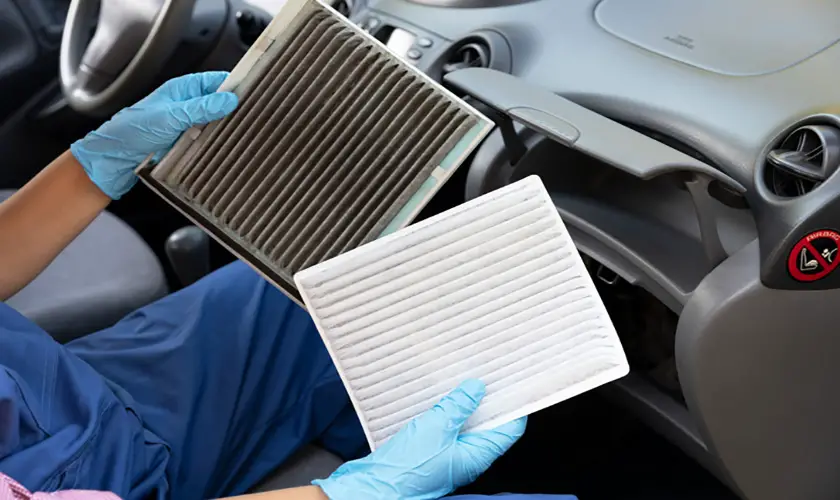
Your vehicle may have a vinegar smell for several reasons. First, you may have accidentally spilled some. Or you may have used some of it to clean your car’s surfaces. After all, it is one of the most popular natural cleaning products around. However, the smell of vinegar may also be moldy odors from stuff in your car that has been exposed to humid conditions.
Once you experience the vinegary smell, know that you have a problem. And that problem needs tackling, especially if you are dealing with mold within your car’s interior. So, it’s crucial to determine the cause of the unpleasant odor to choose the best method of getting rid of it.
Identifying the Potential Causes of the Unpleasant Smell
Why does your vehicle smell your vinegar? First, you need to find out the source of the smell.
For example, if you had an open bottle of vinegar and accidentally spilled some, it could be why you have a vinegar smell in your car, especially if it wasn’t there before. Alternatively, you may have used a lot of vinegar to get rid of puke stains and the resulting vomit smell in your vehicle. If that is the case, the excess use of vinegar could be why your car has that pungent smell.
However, the EPA suggests that mold on interior surfaces should be removed. When exposed to it for a long time, it may cause respiratory issues and skin allergies.

Change Your Car Cabin Air Filters
If the smell of vinegar tends to show up after you switch on your car’s air conditioner (AC) and then lingers for a while after switching it off, you probably have mold growth somewhere in the vehicle. And the chances are high that the mold has formed in your car’s vents. In addition, the pet hair, dust, food particles, dead animals, or any other organic material that accumulates within the air vents may be the cause.
Also, if your cabin air filters are old and dirty, they are not doing their job as they should. So, you may need to replace them.
If you leave it long enough, any liquid that comes into contact with stuff in your vehicle may result in mold growth due to the combination of warmth and excess moisture in the car. For example, if you leave your damp gym clothes or spill water on the floor mat and it fails to dry, mold may begin to form after a while.
In addition, excess condensation from an overflowing condensate pan or a malfunctioning drain line could cause water leaks that may lead to mold growth within the car interior.
Once you determine the source of the problem causing the vinegar odor, you can decide on the approach to use to deal with it.
Approaches for Dealing with the Vinegar-Like Smell
You can deal with the foul odors in your car in three primary ways.
1. Masking the Smell of Vinegar
Masking the smell of vinegar means replacing it with the scent of something more pleasant. When making the vinegar cleaning solution or after cleaning your car, you can do that.
Masking the vinegar smell works best if your car smells unpleasant because you cleaned it with vinegar or spilled some.
2. Neutralizing the Smell of Vinegar
Neutralizing the vinegar smells involves using a substance that will remove the vinegar odor from the vehicle. So, whatever solution you use must have the ability to absorb smells or get rid of bad odors.
3. Removing the Vinegar Smell
Sometimes, the only solution is to remove the source of the vinegar smell from the car. And that may involve replacing some car parts or accessories or removing them temporarily for cleaning purposes. You should use this approach if you have implemented other ways of removing the source of bad smell and failed to achieve your goal.
How to Remove Vinegar Smell from Your Car
Below are some of the easy ways to deal with the unpleasant smell from your car interior.
1. Clear Out Your Trash
Your first order of business is to clear out the trash after opening all the doors to improve airflow and accelerate the reduction of the vinegar smells. Anything in your car that may be causing the moldy smell needs to go, including pet dander, damp clothes, or rotten food.
Also, vacuum all the vehicle surfaces you can reach. In addition, be sure to check out all the nooks and crannies in the car and clean them. And don’t forget to check the car trunk either.
If the trash causes bad odors in your car, you may notice a significant improvement as soon as you get rid of the waste.
2. Clean the Car with a Vinegar Solution
When cleaning your car using vinegar solution, instead of only using vinegar and water to clean your vehicle, you can improve the smell of the cleaner by adding some lemon juice and dish soap and then pouring the mixture into a spray bottle. You can even add club soda or a few drops of your favorite essential oils.
There are many recipes online, so choose what works for you, depending on how much cleaning you have to do and the available ingredients.
To avoid staining your vehicle’s upholstery, you should opt for white vinegar. And when dealing with a stinky area on the car, you can spray the mixture, rub it in with a sponge, leave it on for a few hours, then rinse with clean water.
It is worth noting that vinegar usually removes mildew smells. So, if prolonged water leakages have caused mildew growth in your car, a sweet-smelling vinegar solution will likely do the trick.
Adding pleasant-smelling ingredients to your vinegar tends to mask its smell. So, instead of dealing with a lingering vinegar smell after cleaning, you will experience all the other wonderful scents within the cleaning solution.
3. Absorb Smells in the Car with Baking Soda
Baking soda is one of the go-to solutions when you need to neutralize foul odors. It reacts with acidic and alkali molecules and converts them into neutral-smelling salts.
If you know where the bad smell in your car is coming from, you can sprinkle baking soda generously onto the affected areas and leave it for a few hours or overnight. Then you can vacuum the surfaces in the morning and clean them as usual. However, if the smell is strong, you can use a rag or sponge to rub the baking soda into the stinky areas before leaving it overnight.
If the vinegar stench is due to an unknown reason or the cleaning solution you used, place baking soda in several tiny bowls in different locations around your automobile where the odor is strongest. By morning, it should have neutralized the smell.
4. Neutralize Odors with Coffee Grounds
Coffee grounds will work like baking soda does in removing bad smells from your vehicle’s interior. You can pour them into one or more containers, close all the car doors and windows, and leave the coffee grounds in the car overnight or for an entire day. The musty smell should be gone by then.
However, unlike baking soda, you cannot rub coffee grounds into a stinking vehicle surface. It will stain it.
5. Deodorize your Car Using Charcoal
Activated charcoal is a highly absorbent material capable of eliminating many odors. It provides a large surface area for the absorption of odor-causing molecules. And the best thing about activated charcoal products is that you can reuse them severally.
You should place one or more activated charcoal bags in your car in strategic areas, such as between your car seat and back support, the car trunk, etc. That is the best way to deal with lingering smells every time you clean with vinegar smells from the air vents or other unknown spots. In addition, it can buy you time until you are in a position to have your vehicle checked by a professional.
If you spilled vinegar, you could leave a bowl of activated charcoal in the car overnight to deodorize your car’s interior space.
6. Use a Commercial Air Freshener
If you need a short-term solution to your vinegar problem, spraying your cabin with a commercial air freshener will do the trick. You can use this method to get rid of lingering vinegar smells after removing or cleaning the affected accessories or surfaces.
7. Wash with Water and Car Shampoo
Suppose you spilled some vinegar on your car surfaces and accessories. In that case, you need to wash them with water and car shampoo. The more fragrant the shampoo, the more likely it will mask the vinegar smell.
If necessary, remove the affected accessories, such as floor mats, wash them outside, and dry them before returning them to the vehicle. For example, if you use car seat covers, you can remove and launder them according to the manufacturer’s instructions. Then you can put them back.
Of course, that may not be possible for car seats. When dealing with immovable car parts, you can sponge them with fragrant car shampoo and use a dry /wet vacuum to clean the surfaces or leave the AC on in dry function mode with the doors and windows closed.
8. Use Essential Oils
Essential oils are concentrated plant extracts whose fragrances usually have medicinal benefits. However, they can also act as masking agents for any vinegar smells in the car. You can apply a few drops directly onto the smelly car surfaces, place them on a rag that you can leave in the car, or use an aromatherapy diffuser to spread the droplets around the vehicle’s interior.
9. Steam Clean Your Car
Deep cleaning your car may be the best way to eliminate vinegar smells arising from damp surfaces and stuff you left in it for a long time. And vehicle steam cleaner can help you do that.
Typically, steam cleaners use dry vapor instead of chemicals. But their heat can kill growing mold and mildew.
Before steam cleaning, you need to vacuum your car thoroughly. Then you can use your steam cleaner to detail the entire car and wipe the excess moisture with a microfiber cloth. You can even steam clean the windows and ceiling, making this option one of the most thorough ways to remove the vinegar smell from the interior car surfaces.
10. Switch On the Ozone Machine
If you have a stubborn vinegar smell in your car, you can buy or rent an ozone generator to try and get rid of it. Such devices utilize ozone emissions. They will break down oxygen molecules so that they can bond better to form ozone.
First, you need to clear the trash and everything else to prevent damage. Then you need to vacuum the car and all hard surfaces. After that, you should close all the doors and windows. However, one window should be open enough to allow the ozone generator duct in. But you would need to seal the open area around the duct for the best results.
Depending on the musty smell strength, you can leave the ozone generator on for half an hour to two hours. And for health reasons, you should keep people and pets away from the area for at least two hours.
Ideally, the ozone machine should remove the vinegar smell from the car, even if the moldy smells are coming from the car’s air conditioner and all its related components.
When you have tried everything to get rid of horrible smells in your car, and nothing works, you may need to visit your trusted mechanic at a vehicle repair shop and have your vehicle checked out. Your car’s air filter, HVAC system, battery acid, catalytic converter, and voltage regulator are all potential causes of that vinegar smell if they malfunction. But you won’t know for sure unless a professional investigates your car and deals with the problem.
